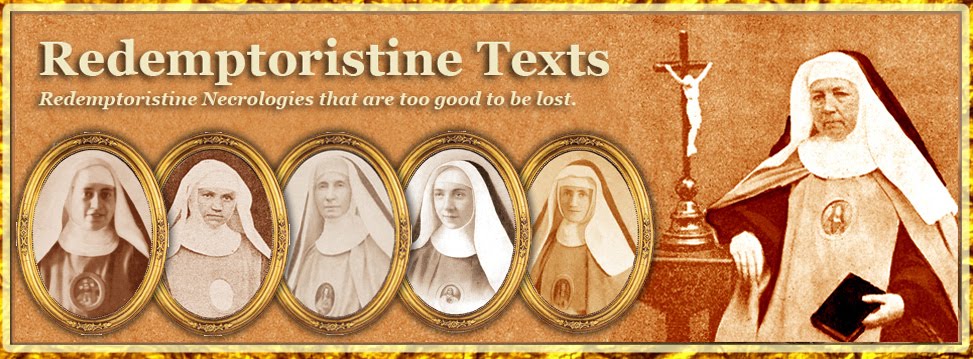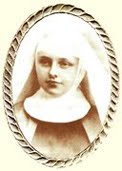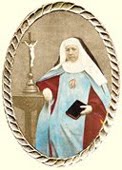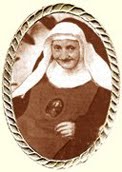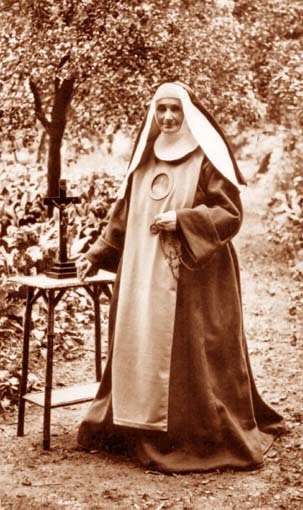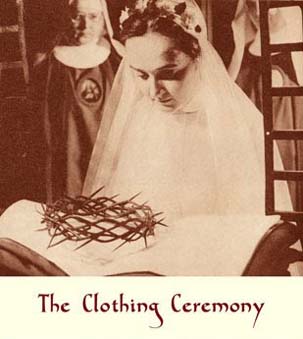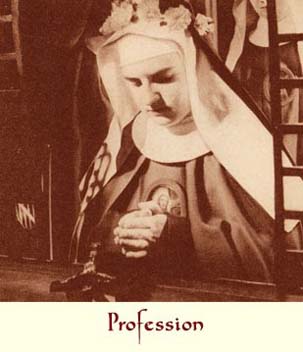1878
God, whose plans are hidden and whose ways to attain them are admirable, wishing to extend our holy Order, for this purpose made use of the mediation of Mons Fava, the Bishop of Grenoble, and Madame the Marquise of Murinais. This last had a sister in the Monastery of Malines (Belgium), whose health was very precarious. As she was little accustomed to the cold climate of the North, Madame the Marquise believed that by bringing her back to where she was born, she could recover her lost health.
She expressed her intentions to Mons Fava, who at first postponed the project. Madame the Marquise did not insist for the moment, but returned prudently to the matter from time to time. A year or two passed in this dilemma, and then Mons the Bishop, on his own initiative, said to Madame de Murinais: “This is now the moment when we can call in the Redemptoristines.”
His Lordship wrote to His Eminence, Cardinal Dechamps, the Archbishop of Malines, to ask him for a small group. The Community of Malines had just made a foundation at Saint-Amand-les-Eaux. It was now poor in subjects, and also, most of the Sisters were unwell, indisposed or invalids. So His Eminence sent this reply: “I suggest having Mother Marie-Veronique of Jesus as Superior, but her health is very poor. Her companion, Sister Marie-Rumoldine is scarcely more robust. If only you could give me a subject with solid good health, capable of keeping strict observance and being a model of regularity … I would straight away give my approval.” Mother Marie-Veronique then approached the Monastery of Bruges to obtain some help. Two religious came forward and offered themselves spontaneously for the accomplishment of this work. The foundation was thus decided and five Sisters got ready to leave. They were the Reverend Mother Marie-Veronique, the Superior; Sister Marie-Rose from Malines, Sister Marie-Gonzaga and Sister Marie-Veronica of the Will of God, from Bruges. And lastly there was Sister Marie-Rumoldine from Malines. The departure took place in the middle of the month of June 1878, and as there was no house prepared for them, they stayed for three weeks with Madame the Marquise de Murinais, who received the travellers with the affection, devotion and respect that she bore for the brides of Jesus-Christ. Having found a furnished villa at La Tronche called Jermoloof, after the Russian general to whom it belonged, the Sisters rented it for a year.
This villa was perfectly situated. They could breathe air that was favourable to feeble lungs, and so they hoped for an improvement in the health of Mother Marie-Veronique. During this time, a pious person, devoted to the community, was looking for a site that would be suitable for the construction of a Monastery. After many unfruitful applications, Miss Dastarac, that was her name, found a modest house near the little seminary at Rondeau. This house was surrounded by two hectares of land. With the approval of Mons the Bishop, they bought it all, and they added a modest construction to it that could at least shelter the Sisters who had already arrived, and the postulants who had joined them. They also built the walls of the enclosure. The Sisters moved there in September 1879. Madame the Marquise de Murinais, wishing to fulfil her role as foundress, provided all the furnishings of the chapel and the house. Thereafter she always continued to devote her self with a perfect disinterest, an incomparable affection and a grandeur of soul equal to her nobility. In addition, she profited from her closeness to the General of the Chartreuses in order to obtain his protection over the nascent Community; and we may say in passing, that it was thanks to her intervention and that of Mons Fava, that the Reverend Fathers never ceased to aid the community. Mons Fava, for his part, showed a quite paternal benevolence towards it. Another very precious auxiliary was Reverend Father Prouvost, who, in all circumstances, showed himself as a devoted friend and good counsellor.
The cross, with which God ordinarily marks His works, did not delay in appearing in the midst of the new foundation. Reverend Mother Marie-Veronique, whose complexion was already so delicate, was attacked by pneumonia, which, in a few days, brought her to the gates of the tomb. This extremity threw the little religious family into a great sadness. Reverend Mother herself, considering the distressing situation in which she was leaving her dear daughters, found it hard to believe that God wanted to call her to Himself at this hour: nonetheless, she accepted His holy will, and made the sacrifice of her life. Two days had scarcely passed away when her soul flew off to her eternal home, on 30th December 1879.
Mother Marie-Veronique of Jesus was born at Maestricht on 2nd July 1821, of a distinguished family. She was only 18 years old when she entered religion. She was an elect soul and God was pleased to fill her with His most intimate favours, and as a friend of contemplation He attached her firmly to Himself. For her part, she gave herself to this call by her flight from exterior faults and her great application to God. She successively filled the most important charges and succeeded Reverend Mother Marie-Alphonse, who had transplanted the Order of the Most Holy Redeemer, and the Reverend Father Passerat held her in great esteem. When thoughts were tending towards a foundation in France, she devoted herself to it wholeheartedly and departed generously, in spite of her feeble health, even though she had to expect the privations and cares which are ordinarily the lot of new foundations, but hoping to procure the glory of God and attract new brides to Jesus-Christ, she sailed over all these particular considerations. Madame the Marquise de Murinais, who was in a position to appreciate her first-hand, had a true veneration for her, and her death filled her with a profound sadness and inexpressible regrets.
Forced now to replace the Reverend Mother Foundress, Mons Fava, who knew the community of Saint-Amand, thought it best to address himself to them to this effect. The choice fell on Reverend Sister Marie-Augustine of the Divine Providence, then the Mistress of Educandes, whom God had endowed with the qualities required for the position of Superior. She had already devoted herself to the foundation of Velp (in Holland) and Saint-Amand, and did not recoil from the new burden that was presented to her, having to heart the glory of God and the prosperity of our holy Order. She left Saint-Amand on 1st February, and was presented by Mons Fava himself to the Sisters of Grenoble on 2nd February 1880. The Sisters welcomed her gratefully, and rendered their obedience to her very readily.
They continued to organise the provisional house and the holy Rule was put into vigour. As the community was very poor, Father Demenjon, the housekeeper of the little seminary at Rondeau, had the kindness to come there and say the holy Mass every day. Moreover, he provided them with stores and other food items at the same price as for the seminary. Monsignor had given him a general permission to enter the enclosure to help the Superior in the organisation of the garden, and finally he made him the Chaplain of the convent to the satisfaction of all the Sisters, a function which he fulfilled with zeal, and a devotion that could not be more paternal right up to his death, which happened on 12th November 1905.
In 1880 appeared the decree for the expulsion of religious communities. Several Belgian Sisters, fearing trouble, demanded and obtained permission to go back to their own country, and this was granted to them.
When calm returned to the country, numerous vocations were announced, and the house became too cramped, so they had to think of building a new Monastery and building a wing to it at the same time, because of the need they were now feeling.
The priest of our parish, Canon Berlioux, who was interested in what we were doing, but was busy himself in building a church and some schools, introduced his architect and builder with whom he was very satisfied. They were accepted, and we can only praise their ability and devotion. The architect, in his modesty, asked for a preparatory plan to be drawn up, which he followed, but subordinated it to his art, and this contributed to making a model convent of these constructions. In 1883, they laid the general foundations of the Monastery and the church, and in the Spring of 1884, Mons Fava came to solemnly lay the first stone. Reverend Mother Marie-Augustine was powerfully supported, in the supervision of the works and the choice of material, by her sister, the Mother Vicar, Sister Marie-Veronica of the Will of God. This dear Sister, who was greatly weakened by the numerous illnesses she had suffered, and by her additional labours, felt her powers exhausted and finally had to go to bed, succumbing to an internal malady that threatened her for a long time. The last sacraments were administered to her, and she received them with faith and resignation. Mons Fava came to visit her on the eve of her death and asked her: “Do you really want to do the will of God?” And she replied: “Yes, Monsignor, on earth as in heaven.” The good Mother Vicar was dying in full consciousness with the sorrow of leaving her dear Sister in the midst of so many different worries, but the encouragement to place all her confidence in the divine Providence and in Our Lady of Perpetual Succour gave her the assurance that she would always receive aid and assistance from her.
Sister Marie-Veronica of the Will of God was born at Nivelle, Nord, and she was of God from her very first years, and spent her youth in serious piety. She helped her good mother bring up her young brothers and sisters. When she believed she was able to leave the paternal home, she entered the Monastery of the Redemptoristines at Bruges, where later on she had the consolation of seeing her younger sister Philomena (Sister Marie-Augustine) come to join her. Eighteen months later, this last was sent from Bruges to the new foundation at Velp, where she spent thirteen years, and in 1880, God reunited the two sisters at Grenoble until the hour when death separated them again, while they waited for the happy day of eternal beatitude.
After the death of Sister Marie-Veronica, as they needed new cells, they finished building a wing to the Monastery and took possession of it in 1886.
In 1889, they constructed the chapel. Monsignor laid its first stone and let them open a subscription. The Chartreuse Fathers lent their powerful support, and thanks to them and a generous benefactress whose daughter was a religious in the Monastery, the chapel was completed. On Saturday, the 17th of the month of August 1890, His Lordship, Mons Fava, in the company of numerous clergy, made the solemn consecration of it under the patronage of Our Lady of Perpetual Succour, to the joy of all the religious. And so it was with hearts overflowing with gratitude that they chanted the Te Deum laudamus!
She expressed her intentions to Mons Fava, who at first postponed the project. Madame the Marquise did not insist for the moment, but returned prudently to the matter from time to time. A year or two passed in this dilemma, and then Mons the Bishop, on his own initiative, said to Madame de Murinais: “This is now the moment when we can call in the Redemptoristines.”
His Lordship wrote to His Eminence, Cardinal Dechamps, the Archbishop of Malines, to ask him for a small group. The Community of Malines had just made a foundation at Saint-Amand-les-Eaux. It was now poor in subjects, and also, most of the Sisters were unwell, indisposed or invalids. So His Eminence sent this reply: “I suggest having Mother Marie-Veronique of Jesus as Superior, but her health is very poor. Her companion, Sister Marie-Rumoldine is scarcely more robust. If only you could give me a subject with solid good health, capable of keeping strict observance and being a model of regularity … I would straight away give my approval.” Mother Marie-Veronique then approached the Monastery of Bruges to obtain some help. Two religious came forward and offered themselves spontaneously for the accomplishment of this work. The foundation was thus decided and five Sisters got ready to leave. They were the Reverend Mother Marie-Veronique, the Superior; Sister Marie-Rose from Malines, Sister Marie-Gonzaga and Sister Marie-Veronica of the Will of God, from Bruges. And lastly there was Sister Marie-Rumoldine from Malines. The departure took place in the middle of the month of June 1878, and as there was no house prepared for them, they stayed for three weeks with Madame the Marquise de Murinais, who received the travellers with the affection, devotion and respect that she bore for the brides of Jesus-Christ. Having found a furnished villa at La Tronche called Jermoloof, after the Russian general to whom it belonged, the Sisters rented it for a year.
This villa was perfectly situated. They could breathe air that was favourable to feeble lungs, and so they hoped for an improvement in the health of Mother Marie-Veronique. During this time, a pious person, devoted to the community, was looking for a site that would be suitable for the construction of a Monastery. After many unfruitful applications, Miss Dastarac, that was her name, found a modest house near the little seminary at Rondeau. This house was surrounded by two hectares of land. With the approval of Mons the Bishop, they bought it all, and they added a modest construction to it that could at least shelter the Sisters who had already arrived, and the postulants who had joined them. They also built the walls of the enclosure. The Sisters moved there in September 1879. Madame the Marquise de Murinais, wishing to fulfil her role as foundress, provided all the furnishings of the chapel and the house. Thereafter she always continued to devote her self with a perfect disinterest, an incomparable affection and a grandeur of soul equal to her nobility. In addition, she profited from her closeness to the General of the Chartreuses in order to obtain his protection over the nascent Community; and we may say in passing, that it was thanks to her intervention and that of Mons Fava, that the Reverend Fathers never ceased to aid the community. Mons Fava, for his part, showed a quite paternal benevolence towards it. Another very precious auxiliary was Reverend Father Prouvost, who, in all circumstances, showed himself as a devoted friend and good counsellor.
The cross, with which God ordinarily marks His works, did not delay in appearing in the midst of the new foundation. Reverend Mother Marie-Veronique, whose complexion was already so delicate, was attacked by pneumonia, which, in a few days, brought her to the gates of the tomb. This extremity threw the little religious family into a great sadness. Reverend Mother herself, considering the distressing situation in which she was leaving her dear daughters, found it hard to believe that God wanted to call her to Himself at this hour: nonetheless, she accepted His holy will, and made the sacrifice of her life. Two days had scarcely passed away when her soul flew off to her eternal home, on 30th December 1879.
Mother Marie-Veronique of Jesus was born at Maestricht on 2nd July 1821, of a distinguished family. She was only 18 years old when she entered religion. She was an elect soul and God was pleased to fill her with His most intimate favours, and as a friend of contemplation He attached her firmly to Himself. For her part, she gave herself to this call by her flight from exterior faults and her great application to God. She successively filled the most important charges and succeeded Reverend Mother Marie-Alphonse, who had transplanted the Order of the Most Holy Redeemer, and the Reverend Father Passerat held her in great esteem. When thoughts were tending towards a foundation in France, she devoted herself to it wholeheartedly and departed generously, in spite of her feeble health, even though she had to expect the privations and cares which are ordinarily the lot of new foundations, but hoping to procure the glory of God and attract new brides to Jesus-Christ, she sailed over all these particular considerations. Madame the Marquise de Murinais, who was in a position to appreciate her first-hand, had a true veneration for her, and her death filled her with a profound sadness and inexpressible regrets.
Forced now to replace the Reverend Mother Foundress, Mons Fava, who knew the community of Saint-Amand, thought it best to address himself to them to this effect. The choice fell on Reverend Sister Marie-Augustine of the Divine Providence, then the Mistress of Educandes, whom God had endowed with the qualities required for the position of Superior. She had already devoted herself to the foundation of Velp (in Holland) and Saint-Amand, and did not recoil from the new burden that was presented to her, having to heart the glory of God and the prosperity of our holy Order. She left Saint-Amand on 1st February, and was presented by Mons Fava himself to the Sisters of Grenoble on 2nd February 1880. The Sisters welcomed her gratefully, and rendered their obedience to her very readily.
They continued to organise the provisional house and the holy Rule was put into vigour. As the community was very poor, Father Demenjon, the housekeeper of the little seminary at Rondeau, had the kindness to come there and say the holy Mass every day. Moreover, he provided them with stores and other food items at the same price as for the seminary. Monsignor had given him a general permission to enter the enclosure to help the Superior in the organisation of the garden, and finally he made him the Chaplain of the convent to the satisfaction of all the Sisters, a function which he fulfilled with zeal, and a devotion that could not be more paternal right up to his death, which happened on 12th November 1905.
In 1880 appeared the decree for the expulsion of religious communities. Several Belgian Sisters, fearing trouble, demanded and obtained permission to go back to their own country, and this was granted to them.
When calm returned to the country, numerous vocations were announced, and the house became too cramped, so they had to think of building a new Monastery and building a wing to it at the same time, because of the need they were now feeling.
The priest of our parish, Canon Berlioux, who was interested in what we were doing, but was busy himself in building a church and some schools, introduced his architect and builder with whom he was very satisfied. They were accepted, and we can only praise their ability and devotion. The architect, in his modesty, asked for a preparatory plan to be drawn up, which he followed, but subordinated it to his art, and this contributed to making a model convent of these constructions. In 1883, they laid the general foundations of the Monastery and the church, and in the Spring of 1884, Mons Fava came to solemnly lay the first stone. Reverend Mother Marie-Augustine was powerfully supported, in the supervision of the works and the choice of material, by her sister, the Mother Vicar, Sister Marie-Veronica of the Will of God. This dear Sister, who was greatly weakened by the numerous illnesses she had suffered, and by her additional labours, felt her powers exhausted and finally had to go to bed, succumbing to an internal malady that threatened her for a long time. The last sacraments were administered to her, and she received them with faith and resignation. Mons Fava came to visit her on the eve of her death and asked her: “Do you really want to do the will of God?” And she replied: “Yes, Monsignor, on earth as in heaven.” The good Mother Vicar was dying in full consciousness with the sorrow of leaving her dear Sister in the midst of so many different worries, but the encouragement to place all her confidence in the divine Providence and in Our Lady of Perpetual Succour gave her the assurance that she would always receive aid and assistance from her.
Sister Marie-Veronica of the Will of God was born at Nivelle, Nord, and she was of God from her very first years, and spent her youth in serious piety. She helped her good mother bring up her young brothers and sisters. When she believed she was able to leave the paternal home, she entered the Monastery of the Redemptoristines at Bruges, where later on she had the consolation of seeing her younger sister Philomena (Sister Marie-Augustine) come to join her. Eighteen months later, this last was sent from Bruges to the new foundation at Velp, where she spent thirteen years, and in 1880, God reunited the two sisters at Grenoble until the hour when death separated them again, while they waited for the happy day of eternal beatitude.
After the death of Sister Marie-Veronica, as they needed new cells, they finished building a wing to the Monastery and took possession of it in 1886.
In 1889, they constructed the chapel. Monsignor laid its first stone and let them open a subscription. The Chartreuse Fathers lent their powerful support, and thanks to them and a generous benefactress whose daughter was a religious in the Monastery, the chapel was completed. On Saturday, the 17th of the month of August 1890, His Lordship, Mons Fava, in the company of numerous clergy, made the solemn consecration of it under the patronage of Our Lady of Perpetual Succour, to the joy of all the religious. And so it was with hearts overflowing with gratitude that they chanted the Te Deum laudamus!
This necrology is translated from Fleurs de l'Institut des Rédemptoristines by Mr John R. Bradbury. The copyright of this translation is the property of the Redemptoristine Nuns of Maitland, Australia. The integral version of the translated book will be posted here as the necrologies appear.
